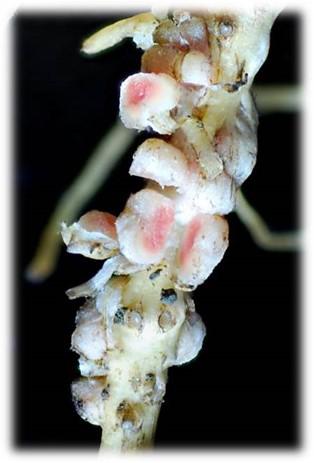Principles of nitrogen fixation and how to maximise it
Ben Hague & Charlotte White
Peas, beans and other legumes fix nitrogen from the atmosphere using the process of biological nitrogen fixation (BNF), whereby atmospheric nitrogen (N2) is combined with hydrogen to form ammonia (NH3). Leguminous crops form symbiotic relationships with rhizobia bacteria in root nodules which provide usable fixed nitrogen to the plant, and in return receive photosynthetic products, such as carbon. Arable pulse crops, such as peas and beans, generally fix between 150 to 240 kg N/ha, representing 50-60% of the total N uptake, but values as high as 400 kg N/ha have been reported. There are several environmental factors which influence BNF; it is most effective when soil temperatures range from 7°C to 20°C; a soil pH of 6.5 is optimal for N fixation to occur and soils below pH 5.5 can inhibit BNF; high
soil mineral N (>200 kg N/ha) reduces BNF, as the plant will not form the symbiosis if sufficient N is available. However, some soil mineral nitrogen (SMN) is required to support crop growth in the three to five week period after emergence, before nodules have developed and started to fix nitrogen.
Here, we will explore the role of appropriate crop husbandry in supporting BNF.
BNF is an expensive process, consuming ~30% of the energy generated by photosynthesis, and must be maintained during flowering to supply sufficient N for seed growth. Therefore, approaches to maintain green leaf area and prolong green canopy duration throughout pod filling must be prioritised. In peas and beans, early establishment can help achieve early flowering, which will reduce the risk heat and drought stress during this critical growth phase and help to extend the overall growing period. For more information on crop establishment see Crop Action Issues 31 – 20th Feb and 33 - 6th March. Appropriate use of disease resistant varieties (see PGRO Pulse Descriptive List) and fungicide applications should also be prioritised to maximise green leaf area and prevent early canopy senescence.

Figure 1:Healthy root nodules on legume crop. (©PGRO)
BNF requires several plant macro- and micronutrients to operate efficiently. Molybdenum, manganese and cobalt are essential nutrients required to support the nitrogenase enzyme, which directly fixes N2, whilst sulphur and phosphorus are used for energy metabolism and amino acid synthesis. Based on an expected yield of 3.5 t/ha for field beans, and 4 t/ha for combining peas, the PGRO Agronomy Guide recommends applying 100 kg/ha of P2O5 on soils with a P index of 0, and 70 kg/ha to soils with an index of 1. Adjustments should be made where yields are likely to be significantly greater or lower.
Sulphur recommendations can vary between sites due to over-winter leaching caused by rainfall, with those on light, sandy soils at a higher risk of sulphur deficiency. However, given that atmospheric deposition of sulphur is now very low, most crops will likely benefit from organic or mineral applications. Data from the pea and bean YENs show a 5 t/ha yielding bean crop takes up 14 kg/ha of S (35 kg/ha of SO3), and a 3.5 t/ha yielding pea crop takes up 9 kg/ha of S (22 kg/ha of SO3). Soil analysis combined with an in-season tissue analysis can be used to check S deficiency. Post harvest grain tests can also indicate if the crop of S deficient. PGRO recommend applying between 25-35 kg/ha of SO3 to combining peas prior to drilling, if deficiency is suspected. Molybdenum, unlike other micronutrients, has decreased bioavailability below a soil pH of 5.5, so liming should be considered to increase availability.
BNF is also sensitive to factors which limit root exploration or nodulation. These are often symptoms of poor soil health, including compaction, poor infiltration or salinity. Appropriate cultivations should be completed to remedy compaction issues (see Crop Action Issue 33 – 6th March for more information).
You can check if your legume’s nodules are actively fixing nitrogen by digging up some plant root systems, washing off the soil from the roots and then carefully cutting the nodules open. If they are pink/red inside, then they are active.
| ACTION - Ensure the crop is not limited for P, S and Mo, as these nutrients are essential for N fixation. - Check to see if your plants have N fixing nodules and whether the nodules are active. - Establish pulse crops where conditions allow and use appropriate fungicide applications to maximise green leaf area. - Check if root growth is being impeded. |
